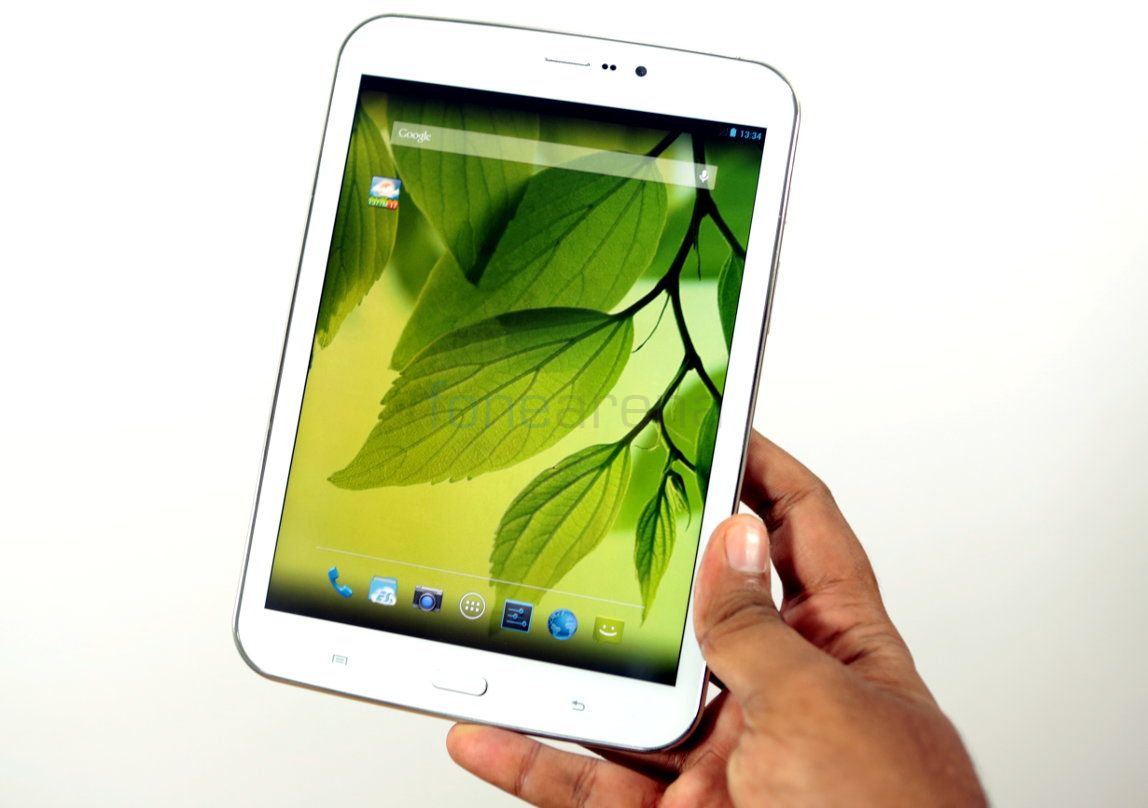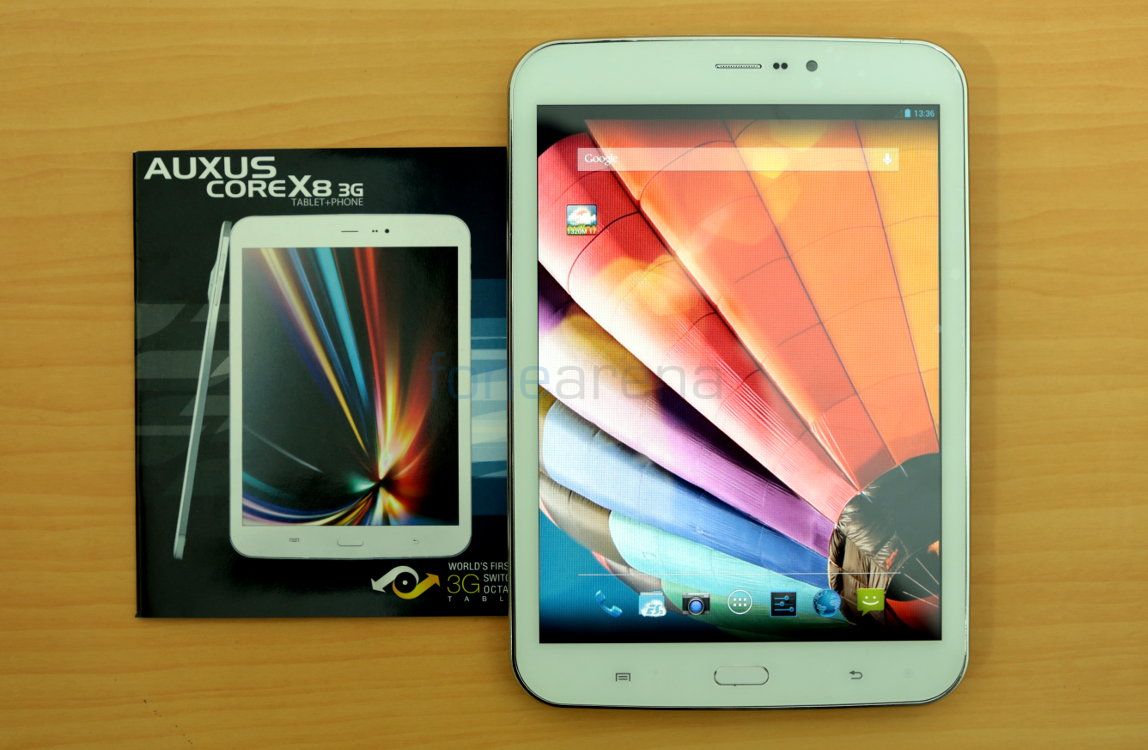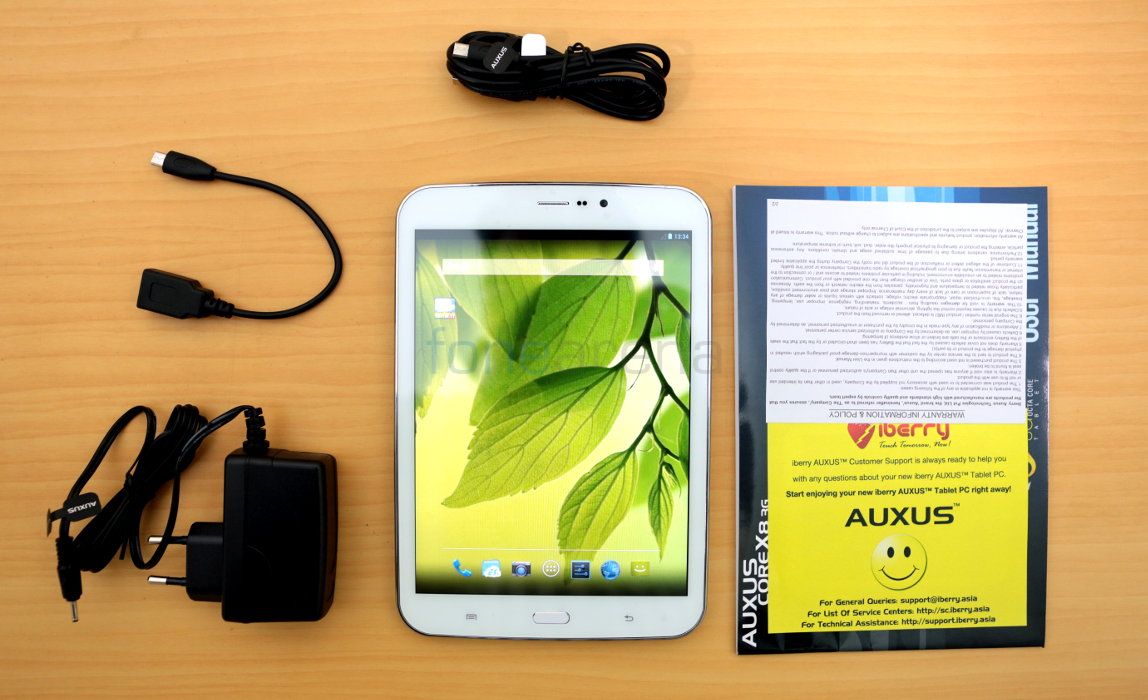

iberry launched the Auxus CoreX8 3G, the company’s latest Android tablet earlier this year. We already brought you the unboxing of the tablet. Here we have the complete review of the tablet. This is one of the first tablets to use Samsung Exynos 5410 processor. It also has 3G support and voice calling capabilities. Is the tablet worth the price? How good is the tablet compared to its competitors? Let us find out.
Unboxing


We unboxed the tablet recently. Check out the iberry Auxus CoreX8 unboxing.
httpv://www.youtube.com/watch?v=uNJ_Fl-AITQ
Box Contents


The box contents include,
- Auxus Core X8 in White
- Proprietary power adapter
- USB OTG cable
- Micro USB cable for data transfer
- Huawei SIM module
- Startup guide and other information booklets
Video Review
httpv://www.youtube.com/watch?v=3SkHMF77Wo0
Hardware
The design of the tablet reminds us of the Samsung Galaxy Tab with curved corners and a home button below the display. The Auxus CoreX8 3G has a 7.85-inch display at a resolution of 1024 by 768 pixels at a pixel density of just 163 ppi. The display is bright, offers vibrant color output and also has 10-Point multi-touch display, but it is too glossy so it is prone to fingerprints. Even though it has ambient light sensors for automatic brightness control, sunlight legibility is not the best. Since the tablet is too wide it is hard to hold comfortably with a single hand for voice calling.
On the top there is an earpiece, the usual set of proximity and ambient light sensors and a 2-megapixel camera with HD video recording.
Below the display there is a physical home button along with capacitive touch buttons for menu and back on either sides, similar to Samsung tablets. The power button has a chrome finish around it, but it is a bit hard to press. There is a small LED light next to the back button that is hardly visible. It glow only when the tablet is charging using the bundled dedicated charger. It glows in red color when the tablet is charging and glows in green when it’s full.
Since the tablet has glossy chrome rim running on the sides, it is not easy to hold. The glossy surface is also prone to fingerprints.
On the right side there is a power button, secondary microphone and volume rockers.
On the top there are dual speaker grills.
There are a lot of ports crammed next to each other on the bottom. On the far left there is a slot for 3G module, next to it is a microSD card slot that supports cards up to 64GB. There is also a USB slot that looks like USB 3.0 slot found on Samsung Galaxy Note 3 and the Galaxy S5, but it actually offers only USB 2.0 speeds. It also has a dedicated mini HDMI port, but it doesn’t come with a HDMI cable. There is a proprietary charging port. You can also find a 3.5mm audio jack and a primary microphone hole on the bottom.
The back is too glossy hence it is prone to fingerprints. For the price the tablet feels cheap and the build quality is below average. At 388 grams, it is too heavy to use it for voice calling.
On the back there is a 5-megapixel camera with LED flash. There is an Auxus branding below the camera module. As you can see, there are tiny patterns of the back, similar to Samsung tablets.
It comes with a separate 3G module that uses a standard SIM card for 3G support and voice calling.
It’s Huawei E1220 3G module. It is a bit hard to remove the module every time when you need to replace the SIM.
Camera
Coming to the camera, the 5-megapixel rear camera is below average. Daylight and Macro shots were decent, but had a lot of noise. Even though it has LED flash low-light images were full of noise. The camera UI is simple and has minimal options such as front and rear camera toggles, Flash toggle, option to adjust white balance and set focus modes (Auto, Macro infinity). Check out few camera samples below.
The tablet is capable of recording videos at 1080p full HD resolution, but the video quality is average without much details.
Software
It runs on Android 4.2.2 (Jelly Bean). The UI pretty much stock and is similar to what you see on most of Android tablets. In the home screen, there is a notification shade on the left side and Quick settings on the right side. In addition to the usual set of toggles, it has a new energy-saving option that is set to improve the battery. As usual you get Google Now feature, but lacks lock screen widgets for some reason. You can’t launch the camera or Google Now directly from the lock screen.
It has 16GB of internal memory out of which 11.07GB is free for storage. 1.4GB of memory is available for app storage. Out of 2GB RAM, about 1.74GB of RAM is usable and about 1.2GB is available when some apps are running in the background. You can also move the apps to the SD card, but you can’t set the default write disk.
Apps
It comes usual set of pre-loaded apps and Google Apps. The Utility apps include, Calculator, Calendar, Clock and Sound Recorder. Other pre-loaded apps include, ES File Explorer, ES Task Manager and UTPlayer. There is a OTA Update app that lets download OTA updates easily. Music player is stock and has equalizer for Bass boost and 3D effect features when you are listening using earphones. Thanks to dual speakers, audio output is pretty good. The stock video player can handle full HD 1080p videos.
Calls and Messaging
It has single SIM support with a standard (mini) SIM card. You can make calls and send SMS, just like a phone. Since the tablet is too heavy and wide, it is impossible to use it as a smartphone.
Connectivity
The connectivity features include, 3G, WiFi 802.11 b/g/n, Bluetooth and GPS. It also has mini HDMI out and USB On the Go (OTG) support.
Performance and Benchmarks
It is powered by a Octa-Core Samsung Exynos 5410 processor (1.6 GHz Cortex A15 + 1.2 GHz Cortex A7 ) with Tri-core PowerVR SGX 544MP GPU that was first introduced last year. Performance was good and we didn’t experience any lags. Thanks to 2GB RAM multitasking was smooth. Check out the scores in some synthetic benchmark tests.
Quadrant Benchmark
It scored 8116 points in the Quadrant benchmark, better that most tablets.
Vellamo 2 HTML5
In the vellamo 2 HTML5 browser benchmark it scored 2040 points and lies just behind Xperia Tablet Z.
Vellamo 2 Metal
It scored 1065 points and tops the Vellamo 2 Metal CPU Subsystem performance test.
NenaMark 2
It clocked 62.5 fps in the NenaMark 2 GPU benchmark.
Basemark X 1.0 HD (Onscreen)
It clocked 19.6 fps in the Basemark X 1.0 on-screen test and is way ahead of other tablets. This is mainly due to its low resolution display and a powerful GPU.
Basemark X 1.0 HD (Offscreen)
It tops even the Basemark X 1.0 HD OffScreen benchmark. We also tested a range of games including Asphalt 8, Riptide GP2 and more. Some graphic-intensive games had occasional frame drops, but the graphics were good.
Battery Life
The tablet packs a 4800 mAh non-removable battery. The battery life is average. It lasts about 5 to 6 hours on mixed usage such as video recording, few voice calls, video playback and some gaming. Continuous 3G use and gaming drains the battery quickly. It requires the proprietary charger to charge quickly. It can also charge through USB, but takes more than 12 hours to charge completely.
Conclusion
Overall the iberry Auxus CoreX8 3G is decent tablet with 3G support, this is definitely not suitable for voice calling since it is too wide and heavy. At a price tag of Rs. 23,990, it is definitely expensive, even though it has a lot of connectivity options and 16GB of internal memory with expansion slot. Price tag, size and the build makes it hard to recommend this Android tablet over other sleek voice calling tablets.
Pros
- 3G support via SIM card slot
- Decent display
- 16GB of internal memory with expansion slot
Cons
- Too wide and heavy for voice calling
- Average build quality
- Slightly on the expensive side
